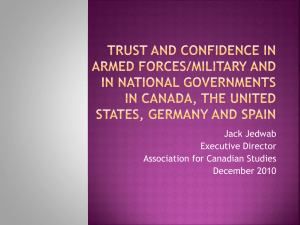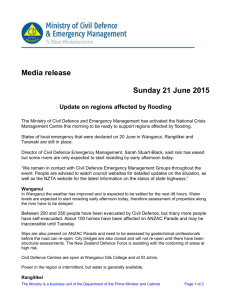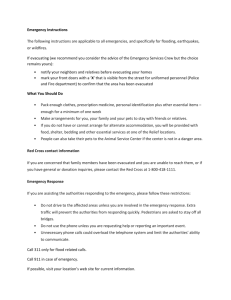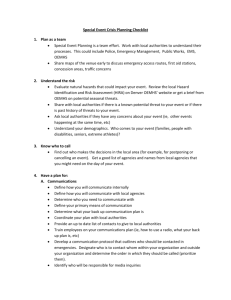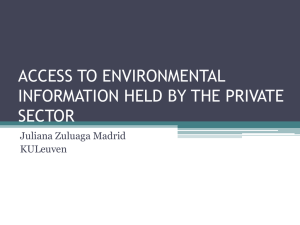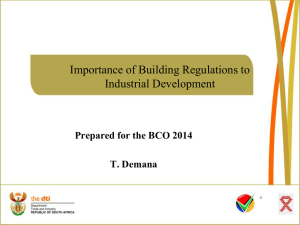role of spanish armed forces in emergencies
advertisement
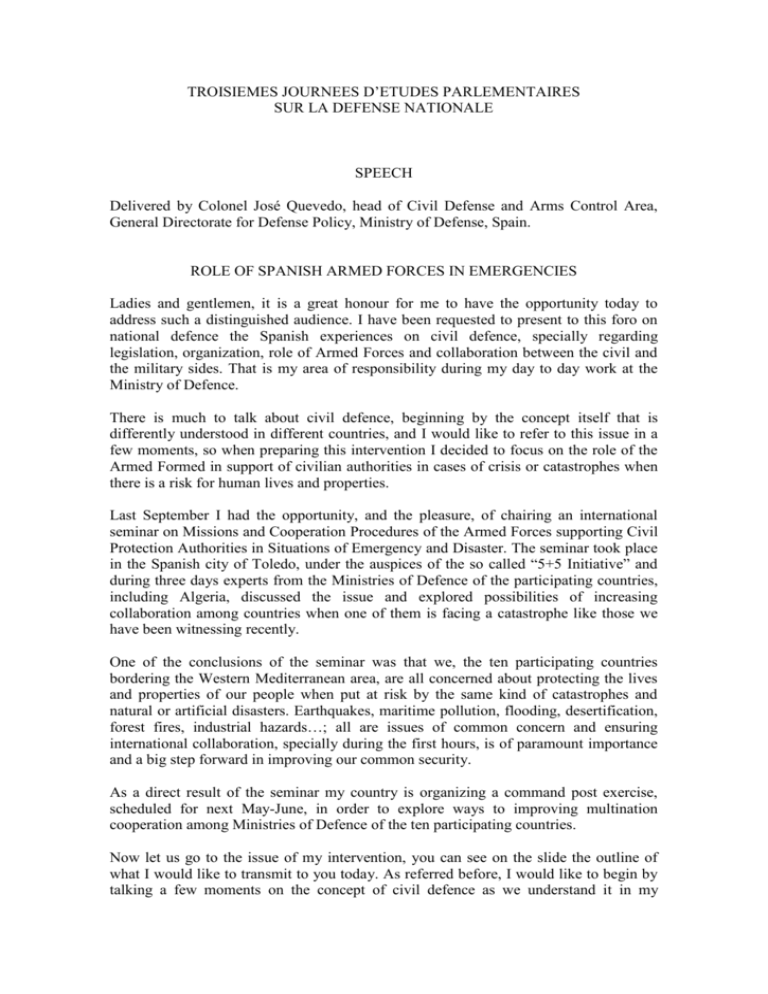
TROISIEMES JOURNEES D’ETUDES PARLEMENTAIRES SUR LA DEFENSE NATIONALE SPEECH Delivered by Colonel José Quevedo, head of Civil Defense and Arms Control Area, General Directorate for Defense Policy, Ministry of Defense, Spain. ROLE OF SPANISH ARMED FORCES IN EMERGENCIES Ladies and gentlemen, it is a great honour for me to have the opportunity today to address such a distinguished audience. I have been requested to present to this foro on national defence the Spanish experiences on civil defence, specially regarding legislation, organization, role of Armed Forces and collaboration between the civil and the military sides. That is my area of responsibility during my day to day work at the Ministry of Defence. There is much to talk about civil defence, beginning by the concept itself that is differently understood in different countries, and I would like to refer to this issue in a few moments, so when preparing this intervention I decided to focus on the role of the Armed Formed in support of civilian authorities in cases of crisis or catastrophes when there is a risk for human lives and properties. Last September I had the opportunity, and the pleasure, of chairing an international seminar on Missions and Cooperation Procedures of the Armed Forces supporting Civil Protection Authorities in Situations of Emergency and Disaster. The seminar took place in the Spanish city of Toledo, under the auspices of the so called “5+5 Initiative” and during three days experts from the Ministries of Defence of the participating countries, including Algeria, discussed the issue and explored possibilities of increasing collaboration among countries when one of them is facing a catastrophe like those we have been witnessing recently. One of the conclusions of the seminar was that we, the ten participating countries bordering the Western Mediterranean area, are all concerned about protecting the lives and properties of our people when put at risk by the same kind of catastrophes and natural or artificial disasters. Earthquakes, maritime pollution, flooding, desertification, forest fires, industrial hazards…; all are issues of common concern and ensuring international collaboration, specially during the first hours, is of paramount importance and a big step forward in improving our common security. As a direct result of the seminar my country is organizing a command post exercise, scheduled for next May-June, in order to explore ways to improving multination cooperation among Ministries of Defence of the ten participating countries. Now let us go to the issue of my intervention, you can see on the slide the outline of what I would like to transmit to you today. As referred before, I would like to begin by talking a few moments on the concept of civil defence as we understand it in my country. I consider it important that we all know what we are referring to when using this concept. Then I will go to the heart of my speech, that being how civil protection is organized in my country and what the role of the Armed Forces is. Here I can say up front that it is an increasingly important role after my Parliament approved very recently, only last November, a new Organic Law on National Defence. Finally, I would like to spend a few minutes commenting some of the recent experiences we have had nationally in facing catastrophes. The first one referring to the case of maritime pollution fuelled by the tanker “Prestige”, and the second on the catastrophe we are facing every year when our forests suffer an unacceptable number of forest fires that allows desertification moving Northwards in what it seems to be a nonstop process. Concept: On the issue of the concept of civil defence, we, in Spain, understand it as the “permanent availability of all human and material resources other than military for national defence, and also for the fight against all kinds of extraordinary catastrophes”. As you may see, the use of military resources is somehow outside the concept of civil defence, but it is included in what we call Civil Emergency Planning. When we use military resources in cases of civil emergencies or catastrophes, which is something that usually happens, we call it “Collaboration of Armed Forces in support of Civil Authorities” and this collaboration is at the core of my presentation here today. Legal framework: Now, after this introduction, let us go to the legal framework. The first thing I would like to stress is the new focus of the Spanish Armed Forces´ missions. Traditionally, those missions were strictly related to preserving the sovereignty, independence, territorial integrity and constitutional system of Spain. In 2002, after the Strategic Revision process that enjoyed broad Parliamentary support, those missions were expanded to include aspects such us: assisting in critical emergencies and catastrophes, evacuation of citizens, supporting key areas of national economy, scientific and technological progress, supporting the State Security Forces, providing transportation for the State’s activities and undertaking search and rescue operations. Lastly, the National Defense Act, approved by the Parliament last November, set up four missions for the Armed Forces, the third of which read out: “Alongside with other State Institutions and public administrations, and according to current legislation, the Armed Forces must preserve citizen’s security and welfare in cases of great risks, catastrophes, calamities or other public necessities”. The Armed Forces have now the legal obligation to equip and prepare themselves to protect citizen’s lives and properties in such a cases, with full respect to the legislation already in place. And, what this legislation is? That related to civil protection. In my country, civil protection is understood as the “physical protection of people and their properties in situations of grave collective risk, public calamity or extraordinary catastrophe”, and is regulated by the Civil Protection Act, approved by Parliament in 1985, and some other legal dispositions as the Royal Decree 407/ 1992 on the Basic Norm on Civil Protection, and Civil Protection Plans (territorial & special), supported by military contingency plans developed by the Chief of Defence Staff. Civil protection structure: Basically, as the Civil Protection Act recognizes it, civil protection is a problem of organization. It is conceived as a public service and the competence lies on the State Civil Administration, particularly on the shoulders of the Ministry of Interior. Decentralization is also a characteristic of the Spanish civil protection system. As you may know, Spain is composed of 17 autonomous regions and 2 cities under special regime. Each of those entities bears responsibility on civil protection. The system is so established in three echelons: Municipalities, Autonomic Regions and State. Each level has the responsibility to produce their own civil protection plans and coordinate those of inferior level. When facing a catastrophe or public calamity that put at risk human lives and properties the principle of subsidiarity applies, meaning by that the first intervention at the lowest level (municipalities) and intervention of upper levels when the scope of emergency so implies. To ensure coordination of different actors involved (civil and military), Civil Protection Commissions and Operative Coordination Centres are envisaged at regional and State levels. It is important to notice that the State level retains the right to declare any situation as of “National interest” when the dimension of the situation so advises. It is also important to stress that, according to the Civil Protection Act, in emergencies, the Armed Forces will collaborate when so requested by the competent civil authorities. That competency is invested to the Minister of Interior, normally through the General Directorate for Civil Protection and Emergencies, set up in 2000 inside the Ministry of Interior, or through the Government Delegates (at autonomic regions level) or Subdelegates (at provincial level). At State level, a series of special plans are to be developed in relationship with: Nuclear emergencies, military conflicts, floods, earthquakes, chemical risks, transports of hazardous merchandise, forest fires, and volcanic risks. Collaboration criteria: But, what are the basic criteria we are using to decide Armed Forces involvement in emergencies?. So far, we were directed by the principle of “exceptionality”, Armed Forces were equipped and prepared to confront a full range of crisis situations, focusing on the more demanding combat situations. Their man power, discipline and special equipment made them a useful tool for emergencies, when civil resources were not enough to cope with the situation, but their lack of specific civil protection preparation made their employment rather exceptional. Today, under the new National Defense Act, and keeping the main responsibility lying on the competent civil authorities, military interventions will be less exceptional and it will increase the resources available to State level civil authorities to face catastrophic situations and public emergencies. As a response to this new mission assigned to the Armed Forces by the Parliament, last October, the Government of Spain decided upon the setting up of a new military unit called: Military Unit for Emergencies. Such a unit will be composed of up to 4.310 specialized personnel and will be deployed in six different bases across the Iberian peninsula and Canary Islands. This military unit will be commanded by a two stars general, will belong to the Ministry of Defence but will be tasked and deployed by the Prime Minister Office, and when used will be able to be reinforced by other military resources. Its mission is to intervene in any part of Spain when decided by the Prime Minister, or any other Minister per delegation, in order to contribute to citizen’s security and welfare in cases of great risks, catastrophes, calamities or other public necessities. This highly specialized military unit will be able to face a broad range of situations, including forest fires fighting; search and rescue operations; nuclear, bacteriological and chemical protection, or logistic support. It will be partially operational before next summer, just to help during the summer campaign against forest fires, and fully operational by the end of 2007. Coming back to other criteria that must be taking into account before using military resources in support of civil authorities, as contained in the Civil protection Act of 1985. There must be an explicit requirement from civilian authorities, including the order to act from the Prime Minister. Civilian authorities will be always in charge. They plan, conduct and are responsible for the operation. Military authorities will only be responsible for accomplishing the assigned tasks. Finally, military units keep its own structure and chain of command. Collaboration procedures: Let us go now to the procedures we are using in order to ensure, as much as possible, an efficient support from the military to the civil authorities. According to a Decree dated back to 1976, the usual procedure for civil authorities asking for military support is as follows: When the representative of the central government in a province (Sub-delegate) or autonomic region (Delegate) are to endure a situation that exceeds their capabilities, they inform the Ministry of Interior (General Directorate for Civil Protection and Emergencies) were the situation will be assessed. If the Ministry of Interior can not cope with the situation with its own means, it will request additional resources from other organisms, including the Ministry of Defense (through the General Directorate on Defense Policy). After the Minister has been informed and the operation authorized, military officers are integrated in the appropriate coordination center, were tasks are assigned for each military unit deployed. There are two exceptions to this general procedure. The first one occurs in cases of great urgency or isolation. When local o regional civil authorities can not communicate in due time through the previously explained system, they can ask for military support from local military authorities in a position to provide such a support. In this cases, both: civil authorities and military commanders are due to report through their respective lines of command as soon as possible on the conditions of the support provided. The second exception applies to frequent support activities, as is the case when supporting civil regional authorities in Galicia (North West Spain) in fighting forest fires every year, or Navy and Air Forces support to the Maritime Safety Society in search and rescue operations in the Sea. In these cases, an agreement is signed between the Ministry of Defense and the competent civil organization in order to regulate the conditions of the support to be provided. Study Cases: That is all I wanted to stress regarding the military role in emergencies in my country. We can go deeper to any point of your interest during the question and answers period. But before concluding I would like to refer to two catastrophic emergencies we had endured rather recently, were the military had taken a significant role. The first one is the so called “Prestige crisis”. As you may remember, in November 2002 the fuel tanker Prestige sank 133 NM away from Cape Finisterre and 260 Km from the Cíes islands. 11.000 Tm of fuel were spilled out affecting most of the Atlantic and Cantabric coast of the Iberian peninsula. Since the very beginning, after civil authorities’ request, the Spanish Navy was present to provide support and ensure jurisdiction in territorial waters. This tragedy was able to mobilize the biggest wave of solidarity all across my country ever seen. Thousand and thousands of civilians volunteered from every country’s corner to help cleaning the coast even working with their bare hands. The Armed Forces were also mobilized very early on and were assigned the following tasks: - Air traffic control (AF) - Support to Sea traffic control (Navy) - Shore cleaning (Army, Navy & AF) - Shore cleaning in areas of difficult access (Army & Navy) - Logistic support (Army, Navy & AF) - Logistic support for civilians (volunteers) (Army) - Bottom cleaning Atlantic I. (Navy, Civil Guards...) An Integrated Coordination Center was set up in A Coruña under the direction of the Deputy Prime Minister. Included in it there was a Situation Center in charge of monitoring the fuel spots and coordinating cleaning operations. I would like to stress here the complexity of this coordination taking into account the great number of agencies involved with competencies in different aspects of the crisis. Finally, 25 ships, 15 aerial vehicles, almost 300 terrestrial vehicles and close to 45.000 military personnel were involved in the operation. They worked around 7.000.000 hours and recollected more than 20.000 Tm of fuel. The second catastrophe I would like to turn your attention to is that related to forest fires. Every year, more than 20.000 forest fires are to be put off in Spain, and around 1.000 square kilometers are devastated, last year 1.800 square kilometers, most of then in the North West area. We had to suffer also last year the lost of 19 human lives (17 fire fighters) and injuries of different considerations in 49 other people. Armed Forces collaboration is included every year in an Annual Plan along with the rest of resources available, including international collaboration. In addition, every year we sing one specific agreement between the Ministry of Defence and the Regional authorities of Galicia, the autonomic region more affected, that regulates the details of Armed Forces support in this region. There is also an agreement between the Ministry of Defence and the Ministry of Infrastructures, trough its General directorate for Biodiversity, according to which the Air Forces operate a fleet of 15 civilian fire fighter aircrafts, the aircrafts belong to the Ministry of Infrastructures and the crews belong to the Air Forces. This military unit denominated 43 Air Force Group, flew more than 2.800 hours last year and delivered more than 50.000 cubic meters of water in fighting forest fires. Last, but not least, I would like to mention the important effort made by the land forces every year, maintaining 1.160 personnel permanently alerted to provide support in prevention and logistic support activities. The soon foreseen operational capability of the new Military Unit for Emergencies will allow to increase very significantly the number of resources available for extinction activities. Its Command & Control capabilities, availability and specialization will imply a substantial improvement in the long standing fight against this serious threat to my country. Ladies and gentlemen, that is the end of my presentation. I want to thank you very much for your attention and stand ready to answer any question you may raise. Alger, February 25th 2006
